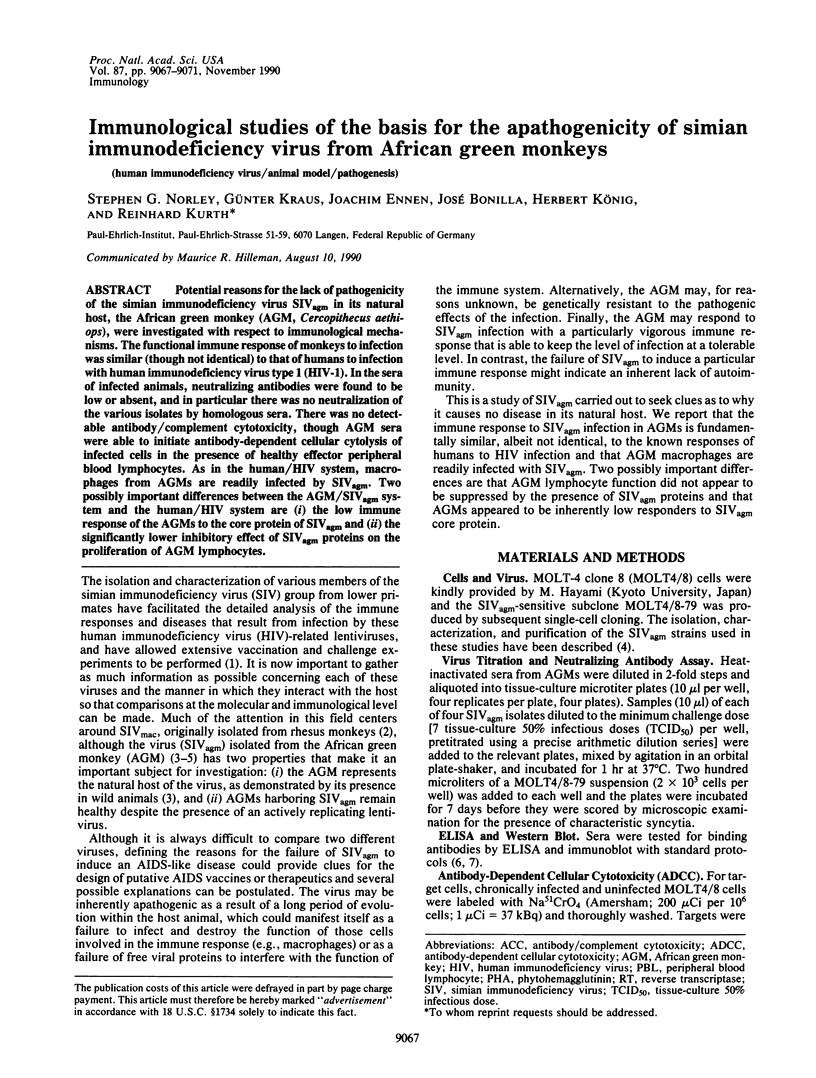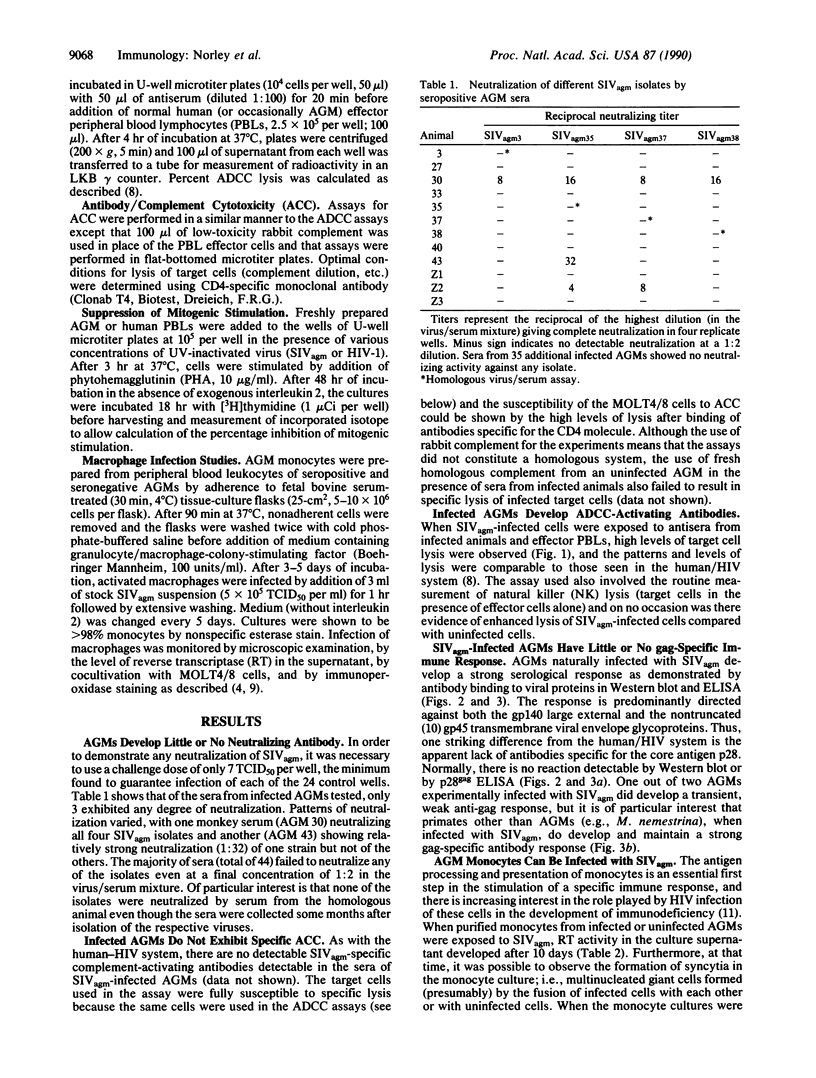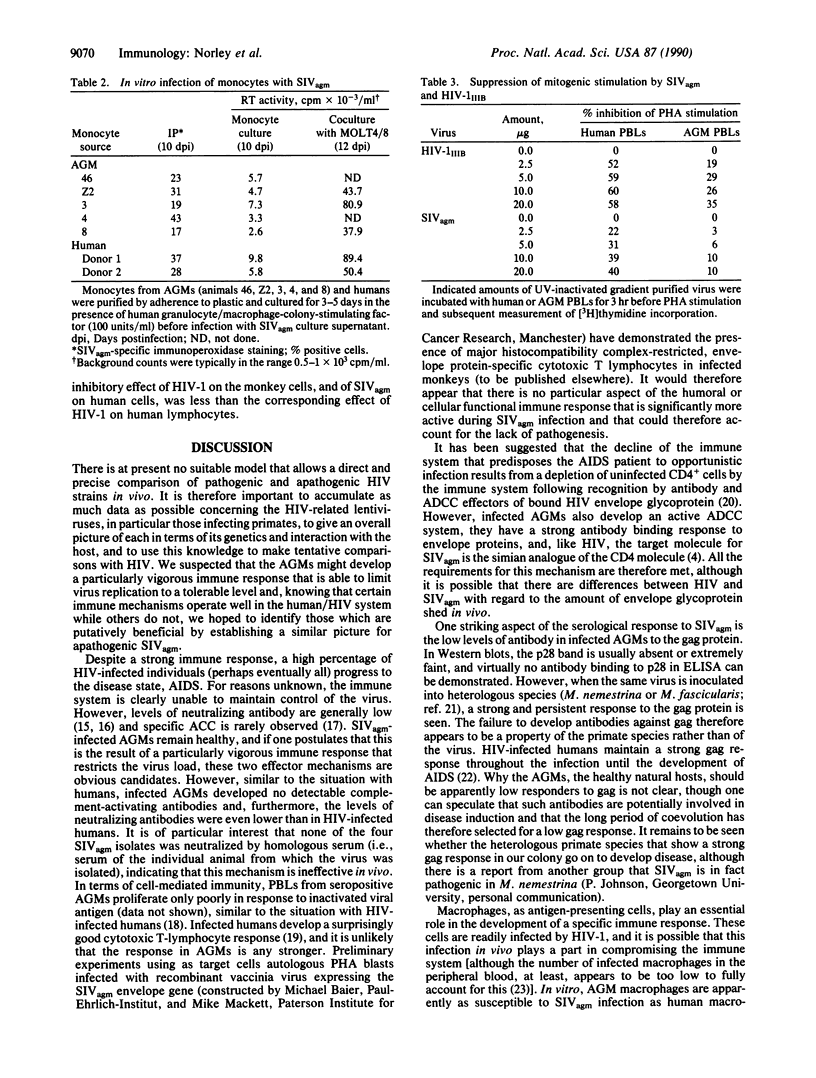Abstract
Potential reasons for the lack of pathogenicity of the simian immunodeficiency virus SIVagm in its natural host, the African green monkey (AGM, Cercopithecus aethiops), were investigated with respect to immunological mechanisms. The functional immune response of monkeys to infection was similar (though not identical) to that of humans to infection with human immunodeficiency virus type 1 (HIV-1). In the sera of infected animals, neutralizing antibodies were found to be low or absent, and in particular there was no neutralization of the various isolates by homologous sera. There was no detectable antibody/complement cytotoxicity, though AGM sera were able to initiate antibody-dependent cellular cytolysis of infected cells in the presence of healthy effector peripheral blood lymphocytes. As in the human/HIV system, macrophages from AGMs are readily infected by SIVagm. Two possibly important differences between the AGM/SIVagm system and the human/HIV system are (i) the low immune response of the AGMs to the core protein of SIVagm and (ii) the significantly lower inhibitory effect of SIVagm proteins on the proliferation of AGM lymphocytes.
Full text
PDF




Images in this article
Selected References
These references are in PubMed. This may not be the complete list of references from this article.
- Daniel M. D., Li Y., Naidu Y. M., Durda P. J., Schmidt D. K., Troup C. D., Silva D. P., MacKey J. J., Kestler H. W., 3rd, Sehgal P. K. Simian immunodeficiency virus from African green monkeys. J Virol. 1988 Nov;62(11):4123–4128. doi: 10.1128/jvi.62.11.4123-4128.1988. [DOI] [PMC free article] [PubMed] [Google Scholar]
- Gartner S., Markovits P., Markovitz D. M., Kaplan M. H., Gallo R. C., Popovic M. The role of mononuclear phagocytes in HTLV-III/LAV infection. Science. 1986 Jul 11;233(4760):215–219. doi: 10.1126/science.3014648. [DOI] [PubMed] [Google Scholar]
- Hoffenbach A., Langlade-Demoyen P., Dadaglio G., Vilmer E., Michel F., Mayaud C., Autran B., Plata F. Unusually high frequencies of HIV-specific cytotoxic T lymphocytes in humans. J Immunol. 1989 Jan 15;142(2):452–462. [PubMed] [Google Scholar]
- Kraus G., Werner A., Baier M., Binniger D., Ferdinand F. J., Norley S., Kurth R. Isolation of human immunodeficiency virus-related simian immunodeficiency viruses from African green monkeys. Proc Natl Acad Sci U S A. 1989 Apr;86(8):2892–2896. doi: 10.1073/pnas.86.8.2892. [DOI] [PMC free article] [PubMed] [Google Scholar]
- Kurth R., Kraus G., Werner A., Hartung S., Centner P., Baier M., Norley S., Löwer J. AIDS: animal retrovirus models and vaccines. J Acquir Immune Defic Syndr. 1988;1(3):284–294. [PubMed] [Google Scholar]
- Lange J. M., Paul D. A., Huisman H. G., de Wolf F., van den Berg H., Coutinho R. A., Danner S. A., van der Noordaa J., Goudsmit J. Persistent HIV antigenaemia and decline of HIV core antibodies associated with transition to AIDS. Br Med J (Clin Res Ed) 1986 Dec 6;293(6560):1459–1462. doi: 10.1136/bmj.293.6560.1459. [DOI] [PMC free article] [PubMed] [Google Scholar]
- Letvin N. L., Daniel M. D., Sehgal P. K., Desrosiers R. C., Hunt R. D., Waldron L. M., MacKey J. J., Schmidt D. K., Chalifoux L. V., King N. W. Induction of AIDS-like disease in macaque monkeys with T-cell tropic retrovirus STLV-III. Science. 1985 Oct 4;230(4721):71–73. doi: 10.1126/science.2412295. [DOI] [PubMed] [Google Scholar]
- Looney D. J., Fisher A. G., Putney S. D., Rusche J. R., Redfield R. R., Burke D. S., Gallo R. C., Wong-Staal F. Type-restricted neutralization of molecular clones of human immunodeficiency virus. Science. 1988 Jul 15;241(4863):357–359. doi: 10.1126/science.3388046. [DOI] [PubMed] [Google Scholar]
- Lyerly H. K., Matthews T. J., Langlois A. J., Bolognesi D. P., Weinhold K. J. Human T-cell lymphotropic virus IIIB glycoprotein (gp120) bound to CD4 determinants on normal lymphocytes and expressed by infected cells serves as target for immune attack. Proc Natl Acad Sci U S A. 1987 Jul;84(13):4601–4605. doi: 10.1073/pnas.84.13.4601. [DOI] [PMC free article] [PubMed] [Google Scholar]
- Mann D. L., Lasane F., Popovic M., Arthur L. O., Robey W. G., Blattner W. A., Newman M. J. HTLV-III large envelope protein (gp120) suppresses PHA-induced lymphocyte blastogenesis. J Immunol. 1987 Apr 15;138(8):2640–2644. [PubMed] [Google Scholar]
- Nara P. L., Robey W. G., Gonda M. A., Carter S. G., Fischinger P. J. Absence of cytotoxic antibody to human immunodeficiency virus-infected cells in humans and its induction in animals after infection or immunization with purified envelope glycoprotein gp120. Proc Natl Acad Sci U S A. 1987 Jun;84(11):3797–3801. doi: 10.1073/pnas.84.11.3797. [DOI] [PMC free article] [PubMed] [Google Scholar]
- Norley S. G., Mikschy U., Werner A., Staszewski S., Helm E. B., Kurth R. Demonstration of cross-reactive antibodies able to elicit lysis of both HIV-1- and HIV-2-infected cells. J Immunol. 1990 Sep 15;145(6):1700–1705. [PubMed] [Google Scholar]
- Ohta Y., Masuda T., Tsujimoto H., Ishikawa K., Kodama T., Morikawa S., Nakai M., Honjo S., Hayami M. Isolation of simian immunodeficiency virus from African green monkeys and seroepidemiologic survey of the virus in various non-human primates. Int J Cancer. 1988 Jan 15;41(1):115–122. doi: 10.1002/ijc.2910410121. [DOI] [PubMed] [Google Scholar]
- Pahwa S., Pahwa R., Good R. A., Gallo R. C., Saxinger C. Stimulatory and inhibitory influences of human immunodeficiency virus on normal B lymphocytes. Proc Natl Acad Sci U S A. 1986 Dec;83(23):9124–9128. doi: 10.1073/pnas.83.23.9124. [DOI] [PMC free article] [PubMed] [Google Scholar]
- Ruegg C. L., Monell C. R., Strand M. Inhibition of lymphoproliferation by a synthetic peptide with sequence identity to gp41 of human immunodeficiency virus type 1. J Virol. 1989 Aug;63(8):3257–3260. doi: 10.1128/jvi.63.8.3257-3260.1989. [DOI] [PMC free article] [PubMed] [Google Scholar]
- Schnittman S. M., Psallidopoulos M. C., Lane H. C., Thompson L., Baseler M., Massari F., Fox C. H., Salzman N. P., Fauci A. S. The reservoir for HIV-1 in human peripheral blood is a T cell that maintains expression of CD4. Science. 1989 Jul 21;245(4915):305–308. doi: 10.1126/science.2665081. [DOI] [PubMed] [Google Scholar]
- Shalaby M. R., Krowka J. F., Gregory T. J., Hirabayashi S. E., McCabe S. M., Kaufman D. S., Stites D. P., Ammann A. J. The effects of human immunodeficiency virus recombinant envelope glycoprotein on immune cell functions in vitro. Cell Immunol. 1987 Nov;110(1):140–148. doi: 10.1016/0008-8749(87)90108-0. [DOI] [PubMed] [Google Scholar]
- Wahren B., Morfeldt-Månsson L., Biberfeld G., Moberg L., Sönnerborg A., Ljungman P., Werner A., Kurth R., Gallo R., Bolognesi D. Characteristics of the specific cell-mediated immune response in human immunodeficiency virus infection. J Virol. 1987 Jun;61(6):2017–2023. doi: 10.1128/jvi.61.6.2017-2023.1987. [DOI] [PMC free article] [PubMed] [Google Scholar]
- Weiss R. A., Clapham P. R., Weber J. N., Dalgleish A. G., Lasky L. A., Berman P. W. Variable and conserved neutralization antigens of human immunodeficiency virus. Nature. 1986 Dec 11;324(6097):572–575. doi: 10.1038/324572a0. [DOI] [PubMed] [Google Scholar]
- Werner A., Baier M., Cichutek K., Kurth R. SIV grows unchanged in human cells. Nature. 1990 Mar 8;344(6262):113–113. doi: 10.1038/344113a0. [DOI] [PubMed] [Google Scholar]
- Werner A., Winskowsky G., Cichutek K., Norley S. G., Kurth R. Productive infection of both CD4+ and CD4- human cell lines with HIV-1, HIV-2 and SIVagm. AIDS. 1990 Jun;4(6):537–544. doi: 10.1097/00002030-199006000-00007. [DOI] [PubMed] [Google Scholar]






